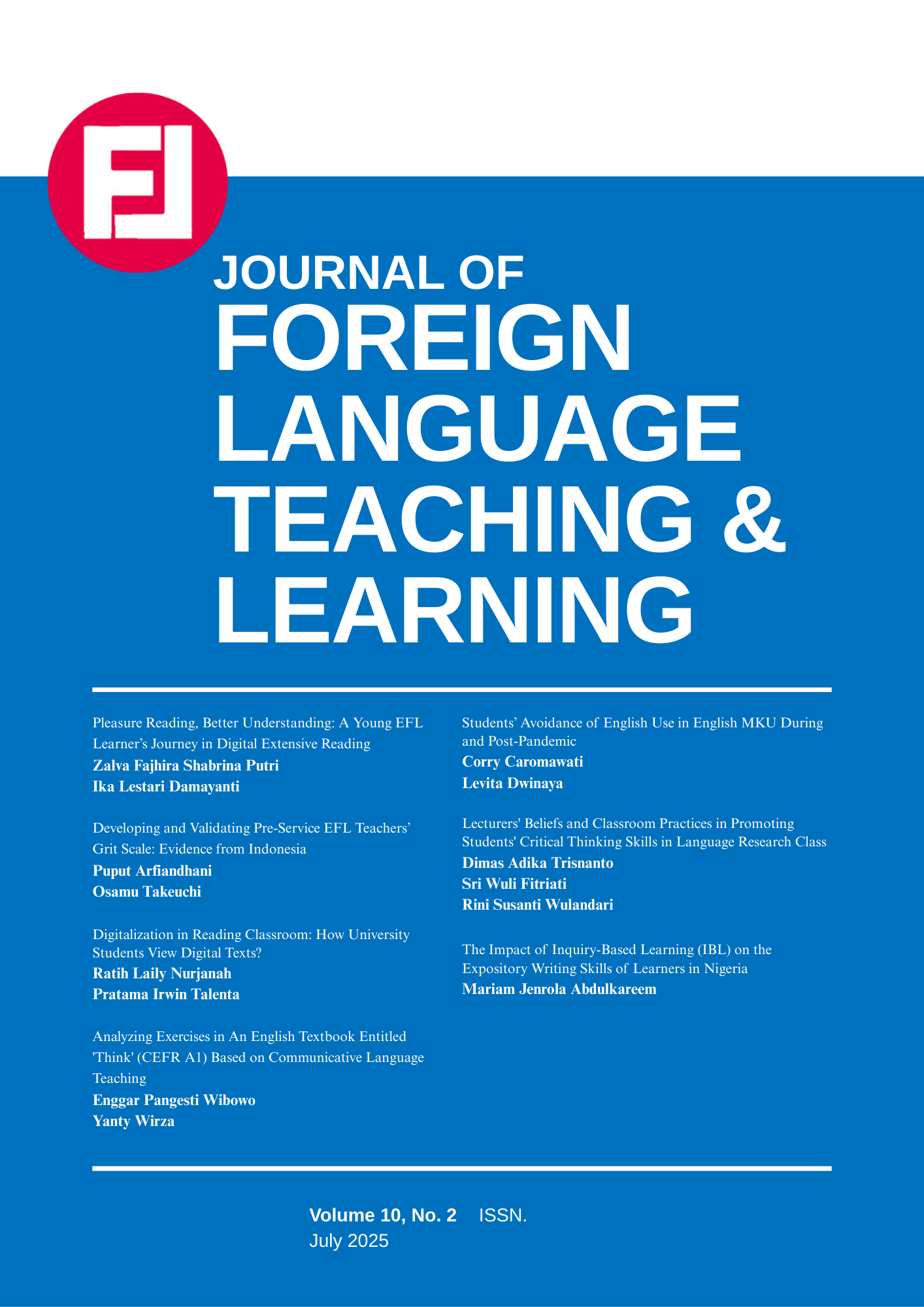Developing and Validating Pre-Service EFL Teachers’ Grit Scale: Evidence from Indonesia
DOI:
https://doi.org/10.18196/ftl.v10i2.27306Keywords:
EFA, CFA, grit, pre-service EFL teachers, scale developmentAbstract
Background: Training to become an English teacher can be challenging for pre-service non-native English language teachers. In L2 English settings, they need to play a unique dual role as L2 teachers-in-training and L2 learners. Unlike trainees in other subjects, EFL teacher trainees use the target language they are still learning as the medium of instruction. Grit, a positive psychology concept referring to passion and perseverance, may help explain their perseverance and passion to become future EFL teachers. However, a specific grit scale to measure pre-service EFL teachers’ grit is still unavailable.
Objective: The purpose of the present study is to develop and validate a pre-service EFL teachers’ (PET) grit scale. The scale was designed to measure pre-service EFL teachers’ grit to become English language teachers.
Methods: To develop and validate the scale, an Exploratory Factor Analysis (EFA) (n = 117) and a Confirmatory Factor Analysis (CFA) (n = 149) were conducted. Participants were final year pre-service EFL teachers in a private teacher training institution in Indonesia.
Findings: The self-report questionnaire comprised 11 items which were categorized into three subscales: passion for professional development, perseverance for professional development, and determination to become English teachers. The results indicated that the scale demonstrated moderate fit indices (RMSEA = .081; CFI = .92; TLI = .89; SRMR = .079, RNI = .92) with a chi-square value of χ² = 81.077 (df = 41). Furthermore, the empirical findings suggested that the newly designed instrument was valid and reliable (ω = 0.81; α = 0.80) for measuring pre-service EFL teachers’ grit.
Conclusion: The present study provides a valid and reliable measurement tool to evaluate the success of pedagogical interventions targeting grit among pre-service EFL teachers. For example, the scale can be utilized to identify pre-service EFL teachers who may need additional support to sustain their grit during challenging phases (e.g., teaching practicum, early stages of teacher training), thus enabling targeted interventions aimed at improving their grit levels. PET-Grit which can help improve teacher training programs and contribute to the growing body of research in this area. Theoretically, the present study highlights the complexity of pre-service EFL teachers' dual roles as both L2 learners and future L2 teachers, demonstrating that grit manifestation is culturally and contextually sensitive, thereby supporting the need for context-sensitive psychological constructs in applied linguistics.
References
Al-Hoorie, A. H., & Hiver, P. (2024). The validation crisis in the L2 motivational self-system tradition. Studies in Second Language Acquisition, 46(2), 307-329. https://doi.org/10.1017/S0272263123000487
Alamer, A. (2021). Grit and language learning: construct validation of L2-Grit scale and its relation to later vocabulary knowledge. Educational Psychology, 41(5), 544–562. https://doi.org/10.1080/01443410.2020.1867076
Alamer, A. (2025). Structural Equation Modeling (SEM) in L2 writing research: Simple tutorial and useful recommendations. Research Methods in Applied Linguistics, 4(2), 100202. https://doi.org/10.1016/j.rmal.2025.100202
Alamer, A., & Marsh, H. (2022). Exploratory Structural Equation Modeling in second language research: An applied example using the dualistic model of passion. Studies in Second Language Acquisition, 44(5), 1477-1500. https://doi.org/10.1017/S0272263121000863
Alamer, A., Schuberth, F., & Henseler, J. (2024). When and how to use Confirmatory Composite Analysis (CCA) in second language research. Studies in Second Language Acquisition, 46(2), 597-616. https://doi.org/10.1017/S0272263124000020
Arfiandhani, P., & Takeuchi, O. (2025). The interplay of grit, enjoyment, and self-efficacy among Indonesian pre-service EFL teachers: an SEM analysis. Asian-Pacific Journal of Second and Foreign Language Education, 10(1), 23. https://doi.org/10.1186/s40862-025-00330-3
Ashadi, A. (2022). Pre-service English language teacher employability issues: Voices from Indonesia. In M. S. Khine & Y. Liu (Eds.), Handbook of Research on Teacher Education: Innovations and Practices in Asia (pp. 399–415). Springer. https://doi.org/10.1007/978-981-16-9785-2_20
Changlek, A., & Palanukulwong, T. (2015). Motivation and grit: Predictors of language learning achievement. Veridian E-Journal, Silpakorn University (Humanities, Social Sciences, and Arts), 8(4), 23-36. https://doi.org/10.1007/978-981-16-9785-2_20
Cheung, G. W., Cooper-Thomas, H. D., Lau, R. S., & Wang, L. C. (2023). Reporting reliability, convergent and discriminant validity with structural equation modeling: A review and best-practice recommendations. Asia Pacific Journal of Management. https://doi.org/10.1007/s10490-023-09871-y
Clark, K. N., & Malecki, C. K. (2019). Academic Grit Scale: Psychometric properties and associations with achievement and life satisfaction. Journal of School Psychology, 72, 49-66. https://doi.org/10.1016/j.jsp.2018.12.001
Credé, M., Tynan, M. C., & Harms, P. D. (2017). Much ado about grit: A meta-analytic synthesis of the grit literature. Journal of Personality and Social Psychology, 113(3), 492. https://doi.org/10.1037/pspp0000102
Datu, J. A. D., Yuen, M., & Chen, G. (2017). Development and validation of the Triarchic Model of Grit Scale (TMGS): Evidence from Filipino undergraduate students. Personality and Individual Differences, 114, 198-205. https://doi.org/10.1016/j.paid.2017.04.012
Datu, J. A. D. (2021). Beyond passion and perseverance: Review and future research initiatives on the science of grit. Frontiers in Psychology, 11, 3914. https://doi.org/10.3389/fpsyg.2020.545526
Dewaele, J. M., & MacIntyre, P. D. (2016). Foreign language enjoyment and foreign language classroom anxiety. The right and left feet of the language learner. In P. D. MacIntyre, T. Gregersen, & S. Mercer (Eds.), Positive psychology in SLA (pp. 215–236). Multilingual Matters. https://doi.org/10.21832/9781783095360-010
Domke, L. M., May, L. A., Kung, M., Coleman, L., Vo, M., & Bingham, G. E. (2022). Pre-service teachers learning to integrate language within content instruction in dual language classrooms. Journal of Multilingual and Multicultural Development, 1–17. https://doi.org/10.1080/01434632.2022.2117817
Dörnyei, Z., & Ushioda, E. (2021). Teaching and Researching Motivation. Routledge.
Duckworth, A. L., Peterson, C., Matthews, M. D., & Kelly, D. R. (2007). Grit: perseverance and passion for long-term goals. Journal of Personality and Social Psychology, 92(6), 1087. https://doi.org/10.1037/0022-3514.92.6.1087
Duckworth, A. L., & Quinn, P. D. (2009). Development and validation of the Short Grit Scale (GRIT–S). Journal of Personality Assessment, 91(2), 166–174. https://doi.org/10.1080/00223890802634290
Duckworth, A. L., Quinn, P. D., & Seligman, M. E. (2009). Positive predictors of teacher effectiveness. The Journal of Positive Psychology, 4(6), 540–547. https://doi.org/10.1080/17439760903157232
Duckworth, A. L., Quinn, P. D., & Tsukayama, E. (2021). Revisiting the factor structure of Grit: A Commentary on Duckworth and Quinn (2009). Journal of Personality Assessment, 103(5), 573–575. https://doi.org/10.1080/00223891.2021.1942022
Dzormeku, C. S., Veermans, K., & McMullen, J. (2024). Linguistic challenges of pre-service teachers in English medium instruction and its relationship to their teaching self-efficacy beliefs. Teaching and Teacher Education, 146, 104632. https://doi.org/10.1016/j.tate.2024.104632
Ebadi, S., Weisi, H., & Khaksar, Z. (2018). Developing an Iranian ELT context-specific grit instrument. Journal of Psycholinguistic Research, 47(4), 975-997. https://doi.org/10.1007/s10936-018-9571-x
Hamid, M. O., Nguyen, H. T. M., & Baldauf, R. B. (2015). Medium of instruction in Asia: Context, processes, and outcomes. In M. O. Hamid, H. T. M. Nguyen, & R. B. Baldauf (Eds.), Language Planning for the Medium of Instruction in Asia (pp. 1-15). Routledge. https://doi.org/10.4324/9781315779560-6
Hejazi, S. Y., Sadoughi, M., & Datu, J. A. D. (2024). The relative importance of growth teaching mindset, emotions, and self‐efficacy in teachers’ grit. International Journal of Applied Linguistics. https://doi.org/10.1111/ijal.12641
Hoang, T., & Wyatt, M. (2021). Exploring the self-efficacy beliefs of Vietnamese pre-service teachers of English as a foreign language. System, 96, 102422. https://doi.org/10.1016/j.system.2020.102422
In’nami, Y., & Koizumi, R. (2011). Structural equation modeling in language testing and learning research: A review. Language Assessment Quarterly, 8(3), 250–276. https://doi.org/10.1080/15434303.2011.582203
Khajavy, G. H., MacIntyre, P. D., & Hariri, J. (2021). A closer look at grit and language mindset as predictors of foreign language achievement. Studies in Second Language Acquisition, 43(2), 379–402. https://doi.org/10.1017/S0272263120000480
Khajavy, G. H., & Aghaee, E. (2022). The contribution of grit, emotions, and personal bests to foreign language learning. Journal of Multilingual and Multicultural Development, 1-15. https://doi.org/10.1080/01434632.2022.2047192
Kline, R. B. (2016). Principles and practice of structural equation modeling (4th ed.). Guilford Press.
Kuruveettissery, S., Gupta, S., & Rajan, S. K. (2021). Development and psychometric validation of the three-dimensional grit scale. Current Psychology, 1-10. https://doi.org/10.1007/s12144-021-01862-w
Lam, K. K. L., & Zhou, M. (2019). Examining the relationship between grit and academic achievement within K-12 and higher education: A systematic review. Psychology in the Schools, 56(10), 1654–1686. https://doi.org/10.1002/pits.22302
Lam, K. K. L., & Zhou, M. (2022). Grit and academic achievement: A comparative cross-cultural meta-analysis. Journal of Educational Psychology, 114(3), 597. https://doi.org/10.1037/edu0000699
Lee, J. S. (2020). The role of grit and classroom enjoyment in EFL learners’ Willingness to Communicate. Journal of Multilingual and Multicultural Development, 1–17. https://doi.org/10.1080/01434632.2022.2039677
Lestari, I. W., Hartono, R., Mujiyanto, J., & Sakhiyya, Z. (2024). Examining pre-service teachers’ professional identity ahead of teaching practicum. Issues in Educational Research, 34(4), 1388–1409.
Li, C., & Dewaele, J. M. (2021). How classroom environment and general grit predict foreign language classroom anxiety of Chinese EFL students. Journal for the Psychology of Language Learning, 3(2), 86-98. https://doi.org/10.52598/jpll/3/2/6
Liu, C., He, J., Ding, C., Fan, X., Hwang, G. J., & Zhang, Y. (2021). Self-oriented learning perfectionism and English learning burnout among EFL learners using mobile applications: The mediating roles of English learning anxiety and grit. Learning and Individual Differences, 88, 102011. https://doi.org/10.1016/j.lindif.2021.102011
Liu, H., Li, X., & Yan, Y. (2023). Demystifying the predictive role of students’ perceived foreign language teacher support in foreign language anxiety: The mediation of L2 grit. Journal of Multilingual and Multicultural Development, 1-14. https://doi.org/10.1080/01434632.2023.2223171
Maclntyre, P. D. (2016). So far so good: An overview of positive psychology and its contributions to SLA. In D. Gabryś-Barker & D. Gałajda (Eds.), Positive psychology perspectives on foreign language learning and teaching (pp. 3–20). Springer International Publishing AG. https://doi.org/10.1007/978-3-319-32954-3_1
Matsunaga, M. (2010). How to factor-analyze your data right: Do’s, don’ts, and how-to’s. International Journal of Psychological Research, 3(1), 97-110. https://doi.org/10.21500/20112084.854
Mueller, R. O., & Hancock, G. R. (2001). Factor analysis and latent structure, confirmatory. International Encyclopedia of the Social & Behavioral Sciences, pp. 5239–5244. https://doi.org/10.1016/b0-08-043076-7/00426-5
Nacario, J. F., Calingasan, K. A., Pendi, O., & Maguing, B. S. (2022, October). The relationship between L2 Grit and intrinsic reading motivation of Filipino pre-service teachers in Central Mindanao. In Proceedings of the 36th Pacific Asia Conference on Language, Information and Computation (pp. 626-636).
Nazari, M., & Alizadeh Oghyanous, P. (2021). Exploring the role of experience in L2 teachers’ turnover intentions/occupational stress and psychological well-being/grit: A mixed methods study. Cogent Education, 8(1), 1892943. https://doi.org/10.1080/2331186x.2021.1892943
Noughabi, M. A., Ghonsooly, B., & Jahedizadeh, S. (2022). Modeling the associations between EFL teachers’ immunity, L2 grit, and work engagement. Journal of Multilingual and Multicultural Development, 1–16. https://doi.org/10.1080/01434632.2022.2088766
Nye, C. D. (2022). Reviewer Resources: Confirmatory Factor Analysis. Organizational Research Methods, 10944281221120541. https://doi.org/10.1177/10944281221120541
Oxford, R., & Khajavy, G. H. (2021). Exploring grit: “Grit Linguistics” and research on domain-general grit and L2 Grit. Journal for the Psychology of Language Learning, 3(2), 7-36. https://doi.org/10.1080/2331186X.2021.1892943
Parks, P. (2017). Understanding the connections between second language teacher identity, efficacy, and attrition: A critical review of recent literature. Journal of Belonging, Identity, Language and Diversity, 1, 75–91.
Plonsky, L., & Derrick, D. J. (2016). A meta‐analysis of reliability coefficients in second language research. The Modern Language Journal, 100(2), 538-553. https://doi.org/10.1111/modl.12335
Plonsky, L., & Gonulal, T. (2015). Methodological synthesis in quantitative L2 research: A review of reviews and a case study of exploratory factor analysis. Language Learning, 65(S1), 9-36. https://doi.org/10.1111/lang.12111
Plonsky, L., & Oswald, F. L. (2014). How big is “big”? Interpreting effect sizes in L2 research. Language Learning, 64(4), 878-912. https://doi.org/10.1111/lang.12079
Richards, J. C. (2023). Teacher, learner and student-teacher identity in TESOL. RELC Journal, 54(1), 252-266. https://doi.org/10.1177/0033688221991308
Riddle, R. A. L. (2018). A predictive correlational study of the relationship between grit and self-efficacy beliefs among pre-service teachers. Liberty University.
Robertson-Kraft, C., & Duckworth, A. L. (2014). True grit: Trait-level perseverance and passion for long-term goals predict effectiveness and retention among novice teachers. Teachers College Record, 116(3), 1–27. https://doi.org/10.1177/016146811411600306
Shirvan, M. E., Lou, N. M., Shahnama, M., & Yazdanmehr, E. (2021). Maintaining effort and interest despite challenges during the COVID-19 pandemic: a process tracing approach to a teacher’s grit during an online L2 course. Journal for the Psychology of Language Learning, 3(2), 45-60. https://doi.org/10.52598/jpll/3/2/4
Shirvan, M. E., Taherian T, Shahnama M. and Yazdanmehr E. (2021). A longitudinal study of foreign language enjoyment and L2 grit: A latent growth curve modeling. Frontier in Psychology, 12(720326). https://doi.org/10.3389/fpsyg.2021.720326
Soleimanzadeh, S., Khajavy, G. H., & Barabadi, E. (2024). Foreign language teacher grit: Scale development and examining the relations with emotions and burnout using relative weight analysis. Applied Linguistics Review, 15(5), 2097-2121. https://doi.org/10.1515/applirev-2022-0076
Sudina, E., Brown, J., Datzman, B., Oki, Y., Song, K., Cavanaugh, R., Bala, T. & Plonsky, L. (2021). Language-specific grit: Exploring psychometric properties, predictive validity, and differences across contexts. Innovation in Language Learning and Teaching, 15(4), 334–351. https://doi.org/10.1080/17501229.2020.1802468
Sudina, E., Vernon, T., Foster, H., Del Villano, H., Hernandez, S., Beck, D., & Plonsky, L. (2021). Development and initial validation of the L2‐Teacher Grit scale. TESOL Quarterly, 55(1), 156–184. https://doi.org/10.1002/tesq.581
Sun, J., & Wang, Y. (2024). Modeling the contribution of grit, hope to perceptions of creativity among Chinese college EFL teachers. Thinking Skills and Creativity, 54, 101665. https://doi.org/10.1016/j.tsc.2024.101665
Takeuchi, O., & Mizumoto, A. (2023). Gaikokugo kyouikukenkyu handbook kaiteiban [The handbook of research in foreign language learning and teaching (3rd edition)]. Shohakusha.
Teimouri, Y., Sudina, E., & Plonsky, L. (2021). On domain-specific conceptualization and measurement of grit in L2 learning. Journal for the Psychology of Language Learning, 3(2), 156-165. https://doi.org/10.52598/jpll/3/2/10
Teimouri, Y., Plonsky, L., & Tabandeh, F. (2022). L2 grit: Passion and perseverance for second-language learning. Language Teaching Research, 26(5), 893-918. https://doi.org/10.1177/1362168820921895
Tupas, R. (2022). The coloniality of native speakerism. Asian Englishes, 24(2), 147–159. https://doi.org/10.1080/13488678.2022.2056797
Waddington, J. (2023). Self-efficacy. ELT Journal, 77(2), 237-240. https://doi.org/10.1093/elt/ccac046
Yabukoshi, T. (2024). Validating a scale to measure self-regulated learning strategies for independent listening beyond the EFL classroom. Research Methods in Applied Linguistics, 3(1), 100090. https://doi.org/10.1016/j.rmal.2023.100090
Yates III, L., Moore, J., Vairez Jr, M. R., Barber-Freeman, P. T., Ross, W., Parker, W. H., & Bautista, R. (2015). The grit of African American male pre-service teachers. Journal of Black School Educators, 1(2), 11-38.
Yin, J. (2019). Connecting theory and practice in teacher education: English-as-a-foreign-language pre-service teachers’ perceptions of practicum experience. Innovation and Education, 1(1), 1–8. https://doi.org/10.1186/s42862-019-0003-z
Zhang, Y., & Huang, J. (2024). Learner identity and investment in EFL, EMI, and ESL contexts: A longitudinal case study of one pre-service teacher. Journal of Language, Identity & Education, 1-14. https://doi.org/10.1080/15348458.2024.2318423
Zein, S. (2022). Translanguaging and multiliteracies in the English to Speakers of Other Languages (ESOL) Classroom. English Teaching, 77, 3-24. https://doi.org/10.15858/engtea.77.s1.202209.3
Downloads
Published
How to Cite
Issue
Section
License
Copyright (c) 2025 Puput Arfiandhani, Osamu Takeuchi

This work is licensed under a Creative Commons Attribution-ShareAlike 4.0 International License.
Copyright
Authors retain copyright and grant the journal right of first publication with the work simultaneously licensed under a Creative Commons Attribution-ShareAlike 4.0 International License that allows others to share the work with an acknowledgment of initial publication in this journal.
Authors are permitted and encouraged to post their work online (e.g., in institutional repositories, social media account, or on their website) after the article getting published in the journal, as it can lead to productive exchanges and earlier and greater citation of published work (See The Effect of Open Access).License
You are free to:
- Share — copy and redistribute the material in any medium or format
- Adapt — remix, transform, and build upon the material for any purpose, even commercially.
Attribution — You must give appropriate credit, provide a link to the license, and indicate if changes were made. You may do so in any reasonable manner, but not in any way that suggests the licensor endorses you or your use.
ShareAlike — If you remix, transform, or build upon the material, you must distribute your contributions under the same license as the original.
- No additional restrictions — You may not apply legal terms or technological measures that legally restrict others from doing anything the license permits.



.png)





